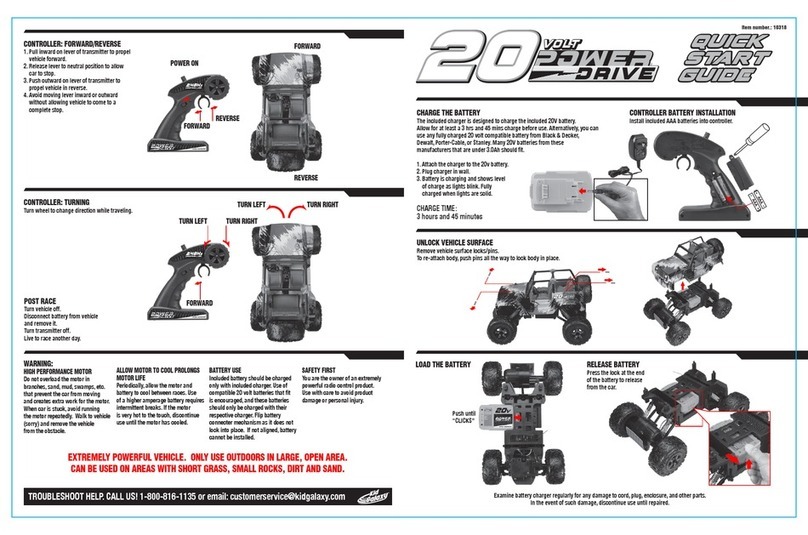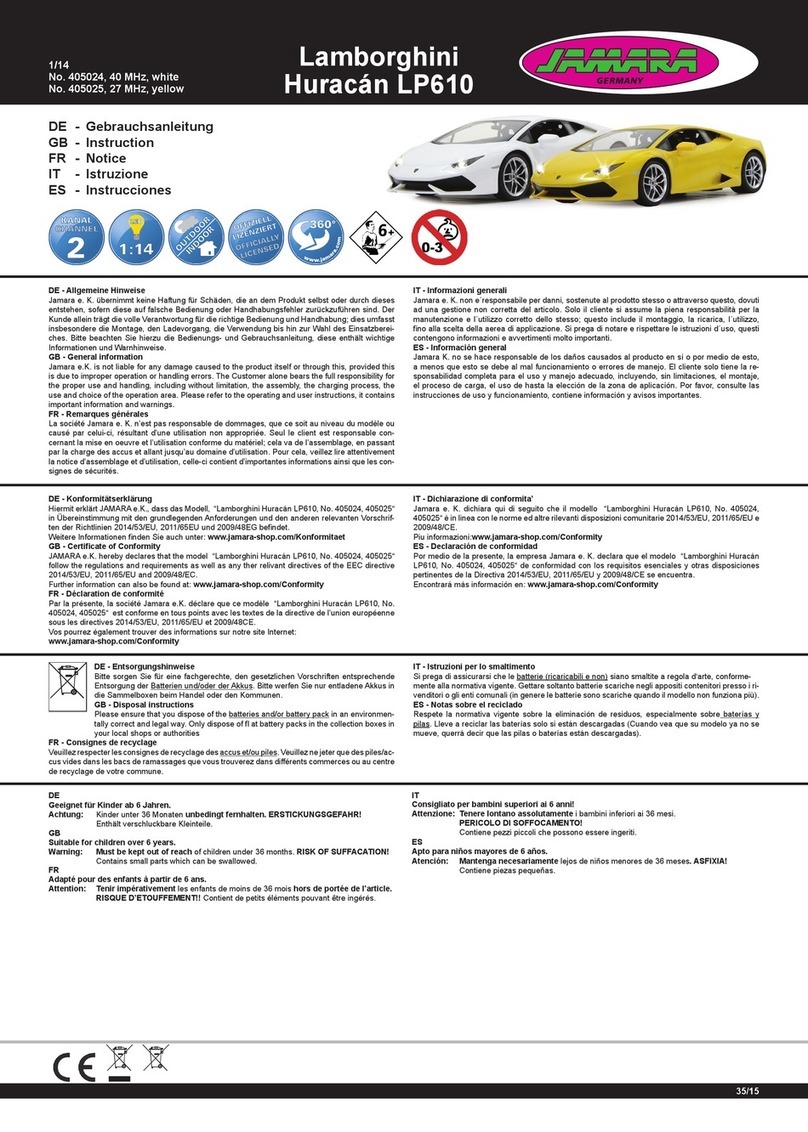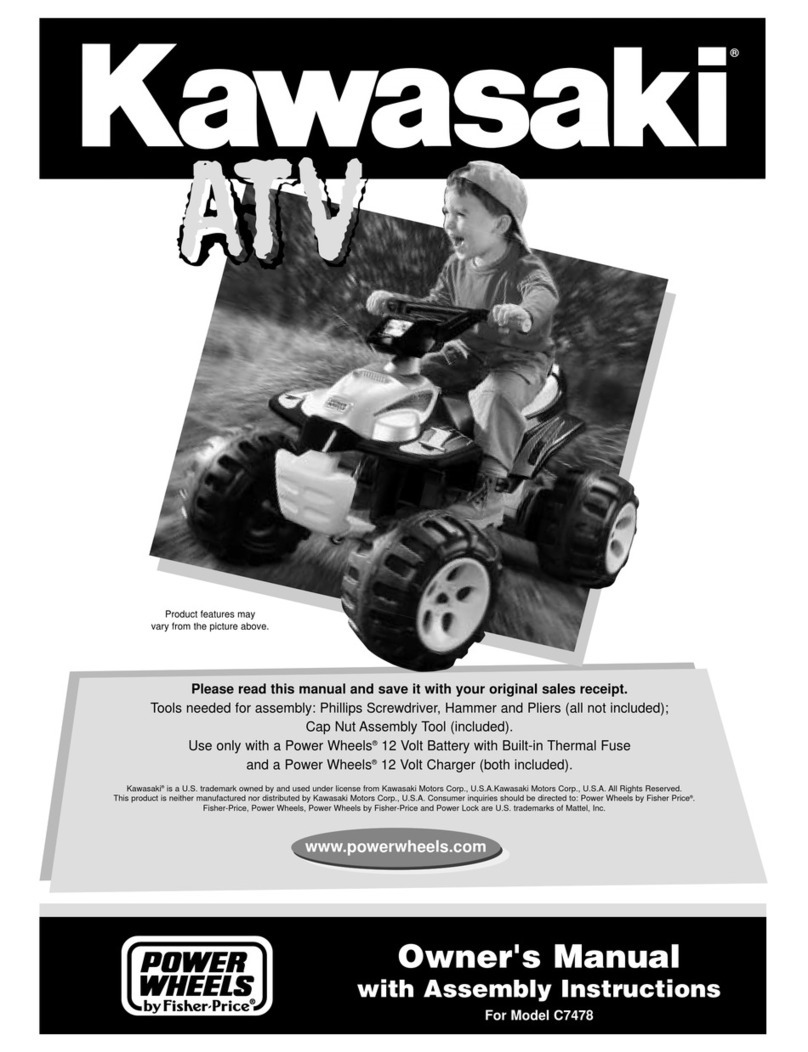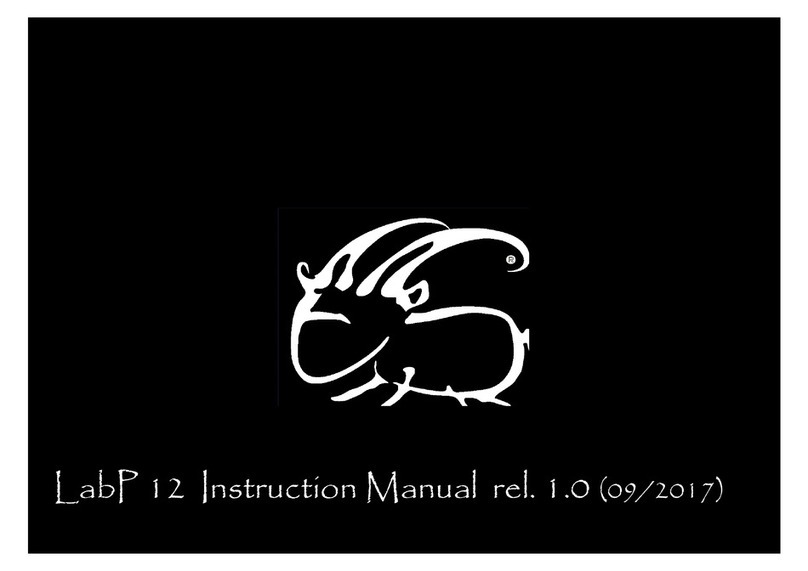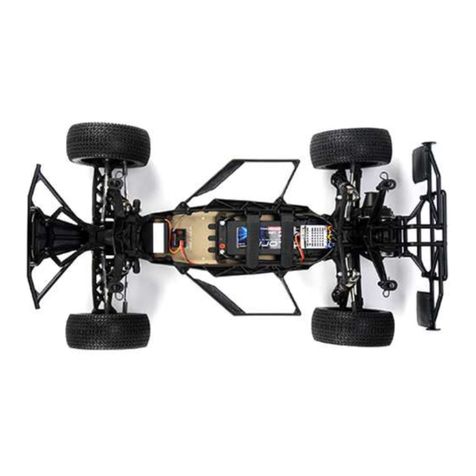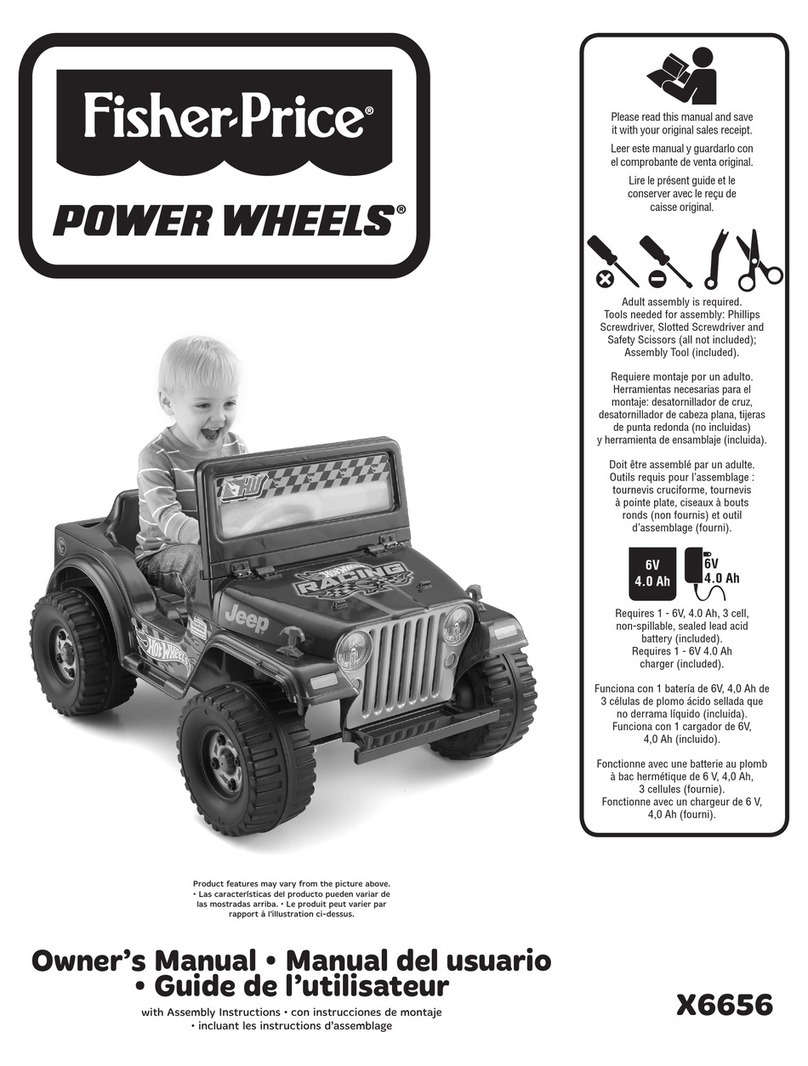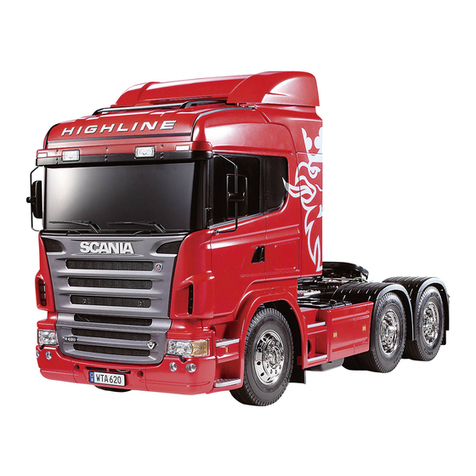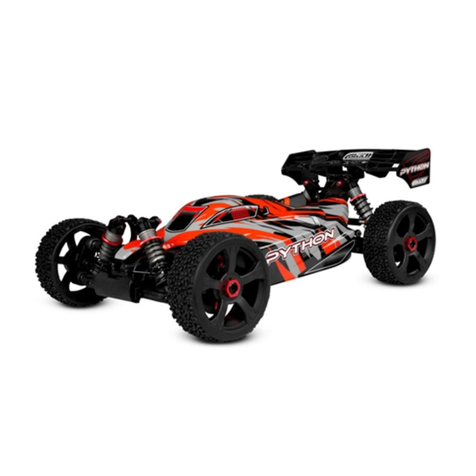Tracker 90 User manual


Your ATV can be hazardous to operate.
A collision or rollover can occur quickly, even during routine maneu-
vers such as turning and driving on hills or over obstacles, if you fail to
take proper precautions. For your safety, it is important to understand
and follow all of the warnings contained in this Operator’s Manual and
the labels on your ATV prior to riding.
Keep this Operator’s Manual with this vehicle at all times. If you lose
your manual, contact your authorized dealer for a replacement. The
labels should be considered permanent parts of the vehicle. If a label
comes off or becomes hard to read, contact your authorized dealer for
a replacement. Contact the manufacturer for proper registration infor-
mation.
FAILURE TO FOLLOW THE WARNINGS CONTAINED IN THIS
MANUAL CAN RESULT IN SERIOUS INJURY OR DEATH.
ALWAYS USE COMMON SENSE WHEN OPERATING THIS
VEHICLE.
Children differ in skills, physical abilities, and judgment. Some children may
not be able to operate an ATV safely. Parents should supervise their child’s
use of the ATV at all times. Parents should permit continued use only if they
determine that the child has the ability to operate the ATV safely.
For your safety, it is important all operators be properly trained to oper-
ate an ATV. Training is available: U.S. owners, call 800-887-2887;
Canadian owners, call 613-739-1535.
Particularly important information is distinguished in this manual by
the following notations:
California Proposition 65
!The Safety Alert Symbol means
ATTENTION! BE ALERT! YOUR
SAFETY IS INVOLVED.
! WARNING WARNING indicates a hazardous sit-
uation which, if not avoided, could
result in death or serious injury.
CAUTION CAUTION, without the safety alert
symbol, is used to address practices
not related to personal injury.
NOTE: A NOTE provides key information to
make procedures easier or more
clear.
! WARNING
The Engine Exhaust from this product contains
chemicals known to the State of California to
cause cancer, birth defects or other reproductive
harm.

1
Foreword
Congratulations and thank you for purchasing a Tracker Off RoadTM All-
Terrain Vehicle (ATV). It is designed to provide superior ride, comfort,
utility, and dependable service.
This Operator’s Manual is furnished to make the operator aware of proper
operating procedures. It also includes information about the general care
and maintenance of your ATV.
Carefully read the following pages. If you have any questions regarding
this ATV, contact an authorized dealer for assistance. Remember, only
authorized dealers have the knowledge and facilities to provide you with
the best service possible.
• Know all local, state/provincial riding laws,
• Respect your ATV,
• Respect the environment, and
• You will gain the respect of others.
We also advise you to strictly follow the recommended maintenance pro-
gram as outlined. This preventive maintenance program is designed to
ensure that all critical components on this ATV are thoroughly inspected at
various intervals.
All information in this manual is based on the latest product data and spec-
ifications available at the time of printing. We reserve the right to make
product changes and improvements which may affect illustrations or
explanations without notice. Because the manufacturer constantly refines
and improves its products, no retroactive obligation is incurred.
You have chosen a quality vehicle designed and manufactured to give
dependable service. Be sure, as the owner/operator of this vehicle, to
become thoroughly familiar with its basic operation, maintenance, and
storage procedures.
Read and understand the entire Operator’s Manual before operating this
vehicle to ensure safe and proper use. Always operate the vehicle within
your level of skill and current terrain conditions.
Division II of this manual covers important information, operator-
related maintenance, and storage instructions. If major repair or service
is ever required, contact an authorized dealer for professional service.
At the time of publication, all information and illustrations in this manual
were technically correct. Some illustrations used in this manual are used
for clarity purposes only and are not designed to depict actual conditions.
Tracker Off Road and the ATV Safety Institute (U.S.) recommend that
all ATV operators ride the appropriate-sized ATV according to age.
Protect Your Sport
Parts and Accessories
When in need of replacement parts, oil, or accessories for your ATV, be
sure to use only GENUINE PARTS, OIL, AND ACCESSORIES. Only
genuine parts, oil, and accessories are engineered to meet the stan-
dards and requirements of this vehicle. For a complete list of acces-
sories, refer to the current ATV/ROV Accessory Catalog.
To aid in service and maintenance procedures on this vehicle, a Service
Manual is available through your authorized dealer.
Category Age (Years) Speed Limitations (mph) NOTES
Y-12+ 12 or Older 15 - Limited
30 - Maximum
Operate Under
Adult Supervision
T-14 14 or Older 20 - Limited
30 - Limited
38 - Maximum
Operate Under
Adult Supervision
G & S 16 or Older According to
Local Regulations
—

2
Table of Contents
Foreword .........................................................................................................1
Parts and Accessories ...................................................................................1
Division I — Rider Awareness/Responsibility
ATV Safety Alert..............................................................................................5
Rider Training Course ....................................................................................6
Hangtags .........................................................................................................7
Warning Labels ...............................................................................................8
Warnings ................................................................................................... 9-15
Prevention ............................................................................................... 17-20
Clothing and Gear ............................................................................... 17
Condition of the ATV ........................................................................... 18
First Aid and Survival .......................................................................... 19
Active Riding.................................................................................................21
Sound Judgment .................................................................................... 22-23
Those Around You .............................................................................. 22
Environment ........................................................................................ 22
Equipment ........................................................................................... 23
Personal Choices ................................................................................ 23
Load Capacity Ratings Chart .............................................................. 23
Supervision ...................................................................................................25
Taking Responsibility .......................................................................... 25
Inexperienced/Untrained Riders ................................................... 25
Experienced/Trained Riders ......................................................... 25
Division II — Operation/Maintenance
ATV Specifications .......................................................................................26
Location of Controls.....................................................................................26
ATV Operation......................................................................................... 27-32
Basic Operating Maneuvers ................................................................ 27
Starting the Engine ....................................................................... 27
Starting a Cold Engine.................................................................. 27
Handling the ATV (Active Riding Techniques) .................................... 28
Tips...................................................................................................... 29
General Information ................................................................................33-38
Control Locations and Functions..........................................................33
Shift Lever ............................................................................................35
Carburetor Float Bowl Drain.................................................................35
Oil Level Stick.......................................................................................35
Seat Lock .............................................................................................36
Safety Flag/Bracket..............................................................................36
Transporting ATV .................................................................................36
Gasoline — Oil — Lubricant.................................................................37
Engine Break-In ...................................................................................38
General Maintenance ..............................................................................39-49
Maintenance Schedule.........................................................................39
Shock Absorbers..................................................................................40
General Lubrication..............................................................................40
Hand Brake System .............................................................................41
Adjusting Brakes ..................................................................................41
Gas/Vent Hoses ...................................................................................42
Protective Rubber Boots ......................................................................42
Battery..................................................................................................43
Spark Plug............................................................................................46
Engine Idle RPM Adjustment ...............................................................46
Throttle Cable Adjustment....................................................................47
Air Filter................................................................................................47
Tires .....................................................................................................48
Wheels .................................................................................................48
Bulb Replacement................................................................................48
Fuse .....................................................................................................49
Storage Compartment/Tools ................................................................49
Preparation for Storage ...............................................................................50
Preparation after Storage ............................................................................ 51
Limited Warranty .......................................................................................... 52
Warranty Procedure/Owner Responsibility ............................................... 53
U.S. EPA Emission Control Statement/Warranty Coverage (U.S. Only).. 54
Maintenance Record ...............................................................................55-56
Change of Address, Ownership, or Warranty Transfer ............................57
Identification Numbers Record ........................................Inside Back Cover

3
! WARNING Indicates a hazardous situation which, if not avoided, could result in death or serious injury.
Division I — Rider Awareness/
Responsibility
AN ATV IS NOT A TOY AND CAN BE
HAZARDOUS TO OPERATE.
An ATV handles differently from other vehicles including motorcycles
and cars. A collision or rollover can occur quickly, even during routine
maneuvers such as turning and driving on hills or over obstacles, if you
fail to take proper precautions. SEVERE INJURY OR DEATH can
result if you do not follow these instructions:
• Parents: It is very important that your child or children understand and follow
the instructions and warnings contained in this manual before operating this
ATV under adult supervision. Also, it is very important that you take time to
watch the Safety DVD (included in the Owner’s Packet) with your child or
children. It contains important operating and safety instructions.
• Read this manual and all labels carefully and follow the operating proce-
dures described.
• Never operate an ATV without proper instruction. Take a training course.
Beginners should receive training from a certified instructor. Contact an
authorized dealer or call the ATV Safety Institute at 800-887-2887 (U.S.) or
the Canada Safety Council at 613-739-1535 (Canada) to find out about the
training course nearest you.
• Never allow anyone under 12 years of age to operate this ATV.
• Never allow a child to operate a Y-12+ ATV without adult supervision and
never allow continued use of an ATV by a child if the child does not have the
abilities to operate it safely.
• Some operators, even at the age of 12, may not be able to operate an ATV
safely; parents should supervise such operator of the ATV at all times. Par-
ents should permit continued use only if they determine that the operator
has the ability to operate the ATV safely.
• Never carry a passenger.
• Never permit a guest to operate this ATV unless the guest has read this
manual and all product labels and has completed a certified training course.
• Never operate an ATV on any paved surfaces, including sidewalks, drive-
ways, parking lots, and streets.
• Never operate this ATV on any public street, highway, or road (even a dirt or
gravel one).
• Never operate an ATV without wearing an approved helmet that fits prop-
erly. You should also wear eye protection (goggles or face shield), gloves,
boots, long-sleeved shirt or jacket, and long pants.
• Never consume alcohol or drugs before or while operating this ATV.
• Never operate at excessive speeds. Always travel at a speed which is proper
for the terrain, visibility and operating conditions, and your experience.
• Never attempt wheelies, jumps, or other stunts.
• Always inspect this ATV each time you use it to make sure it is in safe
operating condition. Always follow the inspection and maintenance proce-
dures and schedules described in this manual.
• Always keep both hands on the handlebars and both feet on the footrests
of the ATV during operation.
• Always go slowly and be extra careful when operating on unfamiliar terrain.
Always be alert to changing terrain conditions when operating the ATV.
• Never operate on excessively rough, slippery, or loose terrain.
• Always follow proper procedures for turning as described in this manual.
Practice turning at slow speeds before attempting to turn at faster
speeds. Do not turn at excessive speed.
• Always have the ATV checked by an authorized dealer if it has been
involved in an accident.
• Never operate the ATV on hills too steep for the ATV or for your abilities.
Practice on smaller hills before attempting larger hills.
• Always follow proper procedures for climbing hills as described in this
manual. Check the terrain carefully before you start up any hill. Never
climb hills with slippery or loose surfaces. Shift your weight forward.
Never open the throttle suddenly. Never go over the top of any hill at high
speed. Always follow proper procedures for going down hills and for brak-
ing on hills as described in this manual. Check the terrain carefully before
you start down any hill. Shift your weight backward. Never go down a hill
at high speed. Avoid going down a hill at an angle which would cause the
ATV to lean sharply to one side. Go straight down the hill where possible.
• Always follow proper procedures for crossing the side of a hill as described
in this manual. Avoid hills with slippery or loose surfaces. Shift your weight
to the uphill side of the ATV. Never attempt to turn the ATV around on any hill
until you have mastered the turning techniques described in this manual on
level ground. Avoid crossing the side of a steep hill if possible.
• Always use proper procedures if you stall or roll backward when climbing a hill.
To avoid stalling, maintain a steady speed when climbing a hill. If you stall or
roll backwards, follow the special procedure for braking described in this man-
ual. Dismount on the uphill side or to either side if pointed straight uphill. Turn
the ATV around and mount following the procedure described in this manual.

4! WARNING Indicates a hazardous situation which, if not avoided, could result in death or serious injury.
AN ATV IS NOT A TOY AND CAN BE
HAZARDOUS TO OPERATE.
• Always check for obstacles before operating in a new area. Never attempt
to operate over large obstacles, such as large rocks or fallen trees.
Always follow proper procedures when operating over obstacles as
described in this manual.
• Always be careful of skidding or sliding. On slippery surfaces, such as
ice, go slowly and be very cautious in order to reduce the chance of skid-
ding or sliding out of control.
• Never operate an ATV in fast flowing water or in water deeper than the
footrests. Remember that wet brakes may have reduced stopping capa-
bility. Test your brakes after leaving water. If necessary, apply them lightly
several times to let friction dry out the pads.
• Always use the size and type tires specified in this manual. Always main-
tain proper tire pressure as described in this manual.
• Never improperly install or improperly use accessories on your ATV.
• Never install a twist grip throttle on this ATV.
• Never exceed the stated load capacity for this ATV. One operator only. No
cargo, passengers, or towing.
• Remove the speed limiting safety device on this ATV at your own risk.
FOR MORE INFORMATION ABOUT ATV SAFETY, call the
ATV Safety Institute at 800-887-2887 (U.S.) or Canada Safety
Council at 613-739-1535 (Canada).

5
! WARNING Indicates a hazardous situation which, if not avoided, could result in death or serious injury.
ATV Safety Alert
The U.S. Consumer Product Safety Commission has concluded that
ALL-TERRAIN VEHICLES (ATVs) may present a risk of DEATH or
SEVERE INJURY in certain circumstances:
*** Each year, about 650 deaths and about 100,000 injuries (including
children) related to off-road vehicles are reported.
*** Many people have become severely paralyzed or suffered severe
internal injuries as a result of accidents associated with ATVs.
*** Every month thousands of people are treated in hospital emergency
rooms for injuries received while riding an ATV.
You should be aware that AN ATV IS NOT A TOY AND CAN BE
HAZARDOUS TO OPERATE. An ATV handles differently from other
vehicles, including motorcycles and cars. A collision or rollover can
occur quickly, even during routine maneuvers such as turning and driv-
ing on hills and over obstacles, if you fail to take proper precautions.
TO AVOID DEATH OR SEVERE PERSONAL
INJURY:
* NEVER ALLOW ANYONE UNDER 12 YEARS OLD TO
OPERATE A TRACKER OFF ROAD Y-12+ ATV.
*ALWAYS
READ THE OPERATOR’S MANUAL CAREFULLY
AND FOLLOW THE OPERATING PROCEDURES DESCRIBED.
PAY SPECIAL ATTENTION TO THE WARNINGS CONTAINED
IN THE MANUAL AND ON ALL LABELS.
* NEVER OPERATE AN ATV WITHOUT PROPER INSTRUCTION.
TAKE A TRAINING COURSE. BEGINNERS SHOULD COM-
PLETE THE TRAINING COURSE DESCRIBED ON PAGE 6.
*NEVER CARRY A PASSENGER OR RIDE AS A PASSENGER
ON AN ATV. CARRYING A PASSENGER MAY UPSET THE
BALANCE OF THE ATV AND MAY RESULT IN LOSS OF CON-
TROL.
* EVERY TRACKER OFF ROAD BRAND ATV IS DESIGNED
FOR A CERTAIN AGE GROUP. NEVER RIDE AN ATV THAT IS
NOT DESIGNED FOR YOUR AGE GROUP. THE OPERATOR’S
MANUAL AND LABELS CONTAIN THE AGE GROUP FOR
EACH ATV.
* NEVER OPERATE A TRACKER OFF ROAD BRAND YOUTH
ATV WITHOUT PARENTAL SUPERVISION.
* NEVER OPERATE AN ATV ON PAVEMENT. THE VEHICLE IS
NOT DESIGNED TO BE USED ON PAVED SURFACES AND
MAY BE DIFFICULT TO CONTROL.
* NEVER OPERATE AN ATV ON A PUBLIC ROAD, EVEN A
DIRT OR GRAVEL ONE, BECAUSE YOU MAY NOT BE ABLE
TO AVOID COLLIDING WITH OTHER VEHICLES. ALSO,
OPERATING AN ATV ON A PUBLIC ROAD MAY BE AGAINST
THE LAW.
* NEVER OPERATE AN ATV WITHOUT AN APPROVED
MOTORCYCLE HELMET, EYE PROTECTION, BOOTS,
GLOVES, LONG PANTS, AND A LONG-SLEEVED SHIRT OR
JACKET.
* NEVER CONSUME ALCOHOL OR DRUGS BEFORE OR
WHILE OPERATING AN ATV.
* NEVER OPERATE AN ATV AT EXCESSIVE SPEEDS. GO AT A
SPEED WHICH IS PROPER FOR THE TERRAIN, VISIBILITY
CONDITIONS, AND YOUR EXPERIENCE.
* NEVER ATTEMPT TO DO WHEELIES, JUMPS, OR OTHER
STUNTS.
*ALWAYS
BE CAREFUL WHEN OPERATING AN ATV, ESPE-
CIALLY WHEN APPROACHING HILLS, TURNS, AND OBSTA-
CLES AND WHEN OPERATING ON UNFAMILIAR OR ROUGH
TERRAIN.
* NEVER LEND YOUR ATV TO ANYONE WHO HAS NOT
TAKEN A TRAINING COURSE OR HAS NOT BEEN DRIVING
AN ATV FOR AT LEAST A YEAR.

6! WARNING Indicates a hazardous situation which, if not avoided, could result in death or serious injury.
Rider Training Course
The manufacturer sponsors a free Rider Training Course to teach AT V
riding skills or to reinforce current riding skills. First-time purchasers
without any previous ATV riding experience will receive a $100.00 cou-
pon from the manufacturer through the Specialty Vehicle Institute of
America/ATV Safety Institute after completing the training course (U.S.
owners only, one incentive). The manufacturer provides free rider train-
ing courses to appropriate immediate family members per ATV pur-
chase. Others can take the training course for a small fee. See an
authorized dealer for details or call 800-887-2887 for training course
information.
In Canada, the Canada Safety Council (CSC) provides an ATV Rider’s
Course to teach safe ATV operating skills. They also provide a special
ATV Rider’s Course for children under 14 years of age with parental
supervision. Call 613-739-1535 for more details. Also available are
safety training materials from the Canadian Off-Highway Vehicle
Distributors Council. Call toll-free at 877-470-2288.
FOR MORE INFORMATION ABOUT ATV
SAFETY in the U.S., call the Consumer
Product Safety Commission at 800-638-
2772 or the ATV Safety Institute Safety
Hotline at 800-852-5344. In Canada, call the
Canada Safety Council at 613-739-1535.

7
! WARNING Indicates a hazardous situation which, if not avoided, could result in death or serious injury.
Hangtags
This vehicle comes with hangtags containing important safety informa-
tion. Anyone who rides the vehicle should read and understand this
information before riding.

8! WARNING Indicates a hazardous situation which, if not avoided, could result in death or serious injury.
Warning Labels
This vehicle comes with several
labels containing important
safety information. Anyone who
rides the vehicle should read and
understand this information
before riding.
The labels should be considered
as permanent parts of the vehicle.
If a label comes off or becomes
hard to read, contact your autho-
rized dealer for a replacement.
KM960A
5411-394
1411-317
G
H
E
1411-809
1411-932
A
2411-137
B
C
0411-836
D
5411-632
F
1411-574

9
! WARNING Indicates a hazardous situation which, if not avoided, could result in death or serious injury.
Warnings
! WARNING
POTENTIAL HAZARD
Operating this ATV without proper instruction and supervision.
WHAT CAN HAPPEN
The risk of an accident is greatly increased if the operator does not
know how to operate the ATV properly in different situations and on
different types of terrain.
HOW TO AVOID THE HAZARD
Beginning and inexperienced operators should complete the certified
training course offered. They should then regularly practice the skills
learned in the course and the operating techniques described in this
Operator’s Manual.
For more information about the training course, contact an autho-
rized dealer or call 1-800-887-2887 (U.S.) or 613-739-1535 (Can-
ada).
! WARNING
POTENTIAL HAZARD
Allowing anyone under age 12 to operate this ATV.
WHAT CAN HAPPEN
Use of an ATV by children can lead to severe injury or death of the
child. Children may not have the skills, abilities, or judgment needed
to operate the ATV safely and may be involved in a serious accident.
HOW TO AVOID THE HAZARD
A child under 12 should never operate this ATV. A child lacking the
skills, abilities, or judgment needed to operate the ATV safely should
never operate this ATV. A child under the age of 16 should never
operate this ATV without parental supervision.
! WARNING
POTENTIAL HAZARD
Carrying a passenger on this ATV.
WHAT CAN HAPPEN
Greatly reduces your ability to balance
and control this ATV. Could cause an
accident, resulting in injury or death to
you and/or your passenger.
HOW TO AVOID THE
HAZARD
Never carry a passenger. The long seat is to allow the operator to
shift positions as needed during operation. It is not for carrying pas-
sengers.
! WARNING
POTENTIAL HAZARD
Operating this ATV on paved surfaces.
WHAT CAN HAPPEN
The ATV’s tires are designed for off-
road use only, not for use on pavement.
Paved surfaces may seriously affect
handling and control of the ATV and
may cause the ATV to go out of control.
HOW TO AVOID THE
HAZARD
Whenever possible, avoid operating the ATV on any paved surfaces
including sidewalks, driveways, parking lots, and streets. If operating
on paved surfaces is unavoidable, travel slowly (less than 10 mph)
and avoid sudden turns and stops.

10 ! WARNING Indicates a hazardous situation which, if not avoided, could result in death or serious injury.
! WARNING
POTENTIAL HAZARD
Operating this ATV on public streets,
roads, or highways.
WHAT CAN HAPPEN
You can collide with another vehicle.
HOW TO AVOID THE
HAZARD
Never operate this ATV on any public
street, road, or highway, even a dirt or
gravel one.
In many states it is illegal to operate an ATV on public streets, roads,
or highways.
! WARNING
POTENTIAL HAZARD
Operating this ATV after or while consuming alcohol or drugs.
WHAT CAN HAPPEN
Could seriously affect your judgment.
Could cause you to react more slowly.
Could affect your balance and perception.
Could result in an accident.
HOW TO AVOID THE HAZARD
Never consume alcohol or drugs before or while driving this ATV.
! WARNING
POTENTIAL HAZARD
Operating this ATV without wearing an
approved motorcycle helmet, eye protec-
tion, and protective clothing.
WHAT CAN HAPPEN
Operating without an approved helmet
increases your chances of a severe head
injury or death in the event of an acci-
dent.
Operating without eye protection can
result in an accident and increases your
chances of a severe injury in the event of
an accident.
Operating without protective clothing
increases your chances of severe injury
in the event of an accident.
HOW TO AVOID THE HAZARD
Always wear an approved helmet that fits properly.
You should also wear:
Eye protection (goggles or face shield)
Gloves
Boots
Long sleeved shirt or jacket
Long pants

11
! WARNING Indicates a hazardous situation which, if not avoided, could result in death or serious injury.
! WARNING
POTENTIAL HAZARD
Operating this ATV at excessive speeds or removing the speed limit-
ing device from the ATV.
WHAT CAN HAPPEN
Increases your chances of losing control of the ATV, which can result
in an accident.
HOW TO AVOID THE HAZARD
Always ride at a speed that is proper for the terrain, visibility and
operating conditions, and your age and experience.
! WARNING
POTENTIAL HAZARD
Attempting wheelies, jumps, and other
stunts.
WHAT CAN HAPPEN
Increases the chance of an accident
including an overturn.
HOW TO AVOID THE
HAZARD
Never attempt stunts, such as wheelies
or jumps. Don’t try to show off.
! WARNING
POTENTIAL HAZARD
Failure to inspect the ATV before operating.
Failure to properly maintain the ATV.
WHAT CAN HAPPEN
Increases the possibility of an accident or equipment damage.
HOW TO AVOID THE HAZARD
Always inspect your ATV each time you use it to make sure the ATV
is in safe operating condition.
Always follow the inspection and maintenance procedures and
schedules described in this Operator’s Manual.
! WARNING
POTENTIAL HAZARD
Failure to use extra care when operat-
ing the ATV on unfamiliar terrain.
WHAT CAN HAPPEN
You can come upon hidden rocks,
bumps, or holes without enough time to
react.
Could result in the ATV overturning or
going out of control.
HOW TO AVOID THE HAZARD
Go slowly and be extra careful when operating on unfamiliar terrain.
Always be alert to changing terrain conditions when operating the
ATV.

12 ! WARNING Indicates a hazardous situation which, if not avoided, could result in death or serious injury.
! WARNING
POTENTIAL HAZARD
Removing hands from handlebar or feet from footrests during opera-
tion.
WHAT CAN HAPPEN
Removing even one hand or foot can reduce your ability to control the
ATV or could cause you to lose your balance and fall off the ATV. If
you remove a foot from a footrest, your foot or leg may come into con-
tact with the wheels, which could injure you or cause an accident.
HOW TO AVOID THE HAZARD
Always keep both hands on the handlebar and both feet on the foot-
rests of your ATV during operation.
! WARNING
POTENTIAL HAZARD
Operating on steep hills.
WHAT CAN HAPPEN
The ATV can overturn more easily on
steep hills than on level surfaces or
small hills.
HOW TO AVOID THE
HAZARD
Never operate the ATV on hills too
steep for the ATV or for your abilities.
Practice on smaller hills before attempting larger hills.
! WARNING
POTENTIAL HAZARD
Turning improperly.
WHAT CAN HAPPEN
ATV could go out of control, causing a collision or rollover.
HOW TO AVOID THE HAZARD
Always follow proper procedures for turning as described in this
Operator’s Manual.
Practice turning at slow speeds before attempting to turn at faster
speeds.
Do not turn at excessive speed.
! WARNING
POTENTIAL HAZARD
Failure to use extra care when operat-
ing on rough, slippery, or loose terrain.
WHAT CAN HAPPEN
Could cause loss of traction or control
of the ATV, which could result in an acci-
dent including an overturn.
HOW TO AVOID THE
HAZARD
Do not operate on rough, slippery, or loose terrain until you have
learned and practiced the skills necessary to control the ATV on such
terrain.
Always be especially cautious on these kinds of terrain.

13
! WARNING Indicates a hazardous situation which, if not avoided, could result in death or serious injury.
NEVER OPERATE UP OR DOWN HILLS
STEEPER THAN 15°
! WARNING
POTENTIAL HAZARD
Climbing hills improperly.
WHAT CAN HAPPEN
Could cause loss of control or
cause the ATV to overturn.
HOW TO AVOID THE HAZARD
Always follow proper procedures for climbing hills as described in this
Operator’s Manual.
Always check the terrain carefully before you start up any hill.
Never climb hills with slippery or loose surfaces.
Shift your weight forward.
Never open the throttle suddenly. The ATV could flip over backwards.
Never go over the top of any hill at high speed. An obstacle, a sharp
drop, or another vehicle or person could be on the other side of the
hill.
! WARNING
POTENTIAL HAZARD
Going down a hill improperly.
WHAT CAN HAPPEN
Could cause loss of control or cause the
ATV to overturn.
HOW TO AVOID THE
HAZARD
Always follow proper procedures for
going down hills as described in this Operator’s Manual.
Always check the terrain carefully before you start down any hill.
Shift your weight backward.
Never go down a hill at high speed.
Avoid going down a hill at an angle that would cause the ATV to lean
sharply to one side. Go straight down the hill where possible.
! WARNING
POTENTIAL HAZARD
Operating the ATV through deep or fast flowing water.
WHAT CAN HAPPEN
Tires may float, causing loss of traction and loss of control, which
could lead to an accident.
HOW TO AVOID THE HAZARD
Never operate the ATV in fast flowing water or in water deeper than
the footrests.
Remember that wet brakes may have reduced stopping capability.
Test your brakes after leaving water. If necessary, apply them several
times to dry out the brakes.

14 ! WARNING Indicates a hazardous situation which, if not avoided, could result in death or serious injury.
! WARNING
POTENTIAL HAZARD
Stalling, rolling backwards, or improp-
erly dismounting while climbing a hill.
WHAT CAN HAPPEN
Could result in the ATV overturning.
HOW TO AVOID THE
HAZARD
Use proper gear and maintain steady
speed when climbing a hill.
If you lose all forward speed:
Keep weight uphill.
Apply the brakes.
Engage the parking brake after you are stopped.
If you begin rolling backwards:
Keep weight uphill.
Gradually apply the brakes while rolling backwards.
When fully stopped, engage the parking brake.
Dismount on uphill side or to a side if pointed straight uphill.
Turn the ATV around and mount following the procedure described in
this Operator’s Manual.
! WARNING
POTENTIAL HAZARD
Operating the ATV with improper tires or with improper or uneven tire
pressure.
WHAT CAN HAPPEN
Use of improper tires on the ATV, or operation of the ATV with
improper or uneven tire pressure, may cause loss of control increas-
ing your risk of accident.
HOW TO AVOID THE HAZARD
Always use the size and type tires specified in this Operator’s Manual
for this ATV.
Always maintain proper tire pressure as described in this Operator’s
Manual.
! WARNING
POTENTIAL HAZARD
Skidding or sliding.
WHAT CAN HAPPEN
You may lose control of the ATV.
You may also regain traction unexpectedly, which may cause the ATV
to overturn.
HOW TO AVOID THE HAZARD
Learn to safely control skidding or sliding by practicing at slow
speeds and on level, smooth terrain.
On extremely slippery surfaces, such as ice, go slowly and be very
cautious in order to reduce the chance of skidding or sliding out of
control.

15
! WARNING Indicates a hazardous situation which, if not avoided, could result in death or serious injury.
! WARNING
POTENTIAL HAZARD
Improperly operating over obstacles.
WHAT CAN HAPPEN
Could cause loss of control or a collision. Could cause the ATV to
overturn.
HOW TO AVOID THE HAZARD
Before operating in a new area, check for obstacles.
Never attempt to ride over large obstacles, such as large rocks or
fallen trees.
When you go over obstacles, always follow proper procedures as
described in this Operator’s Manual.
! WARNING
POTENTIAL HAZARD
Operating the ATV with improper modifications.
WHAT CAN HAPPEN
Improper installation of accessories or modification of the ATV may
cause changes in handling which could lead to an accident.
HOW TO AVOID THE HAZARD
Never modify the ATV through improper installation or improper use
of accessories. All parts and accessories added to this ATV should
be approved components designed for use on the vehicle and should
be installed and used according to instructions. Never install a twist
grip throttle. If you have questions, consult an authorized dealer.
! WARNING
POTENTIAL HAZARD
Improperly crossing hills or turning on hills.
WHAT CAN HAPPEN
Could cause loss of control or cause the
ATV to overturn.
HOW TO AVOID THE
HAZARD
Avoid crossing the side of a hill or turning on
a hill whenever possible. Never attempt to turn the ATV around on
any hill until you have mastered the turning technique as described in
this Operator’s Manual. Practice first on level ground. Be very careful
when turning on any hill.
If crossing the side of a hill or turning on a hill is unavoidable:
Always follow proper procedures as described in this Operator’s Manual.
Avoid hills with slippery or loose surfaces.
Shift your weight to the uphill side of the ATV.
! WARNING
POTENTIAL HAZARD
Failure to release the parking brake before driving the ATV.
WHAT CAN HAPPEN
Driving the ATV with the parking brake engaged could cause a
change in handling or loss of brakes and cause an accident.
HOW TO AVOID THE HAZARD
Always release the parking brake before driving the ATV.

16 ! WARNING Indicates a hazardous situation which, if not avoided, could result in death or serious injury.
California Proposition 65
! WARNING
The Engine Exhaust from this product contains
chemicals known to the State of California to
cause cancer, birth defects or other reproductive
harm.

17
! WARNING Indicates a hazardous situation which, if not avoided, could result in death or serious injury.
Prevention
Overview
When using an ATV, prevention is the name of the game. “Had you only
known” something could go wrong, you would have prevented it. If you
don’t notice your conditions and surroundings before riding your ATV, you
give up control over the situation. Using ATV prevention techniques helps
you forecast potential hazards before they injure you or damage your ATV.
Following the safety instructions and warnings in this manual will help
you “P.A.S.S.” the safety test. P.A.S.S. stands for “Prevention,” “Active
Riding,” “Sound Judgment,” and “Supervision.” Remembering P.A.S.S.
and what it stands for will help you have a safe, predictable ride every
time you go out on your ATV.
You’ll find it important to dress correctly for ATV
riding in order to prevent scraped skin and serious
head injuries. It’s easy and could save you time in
the long run not having to contend with an injury.
Of course, it also makes sense to remember the
seasons. Wear a hat under your helmet and a
snowmobile suit in the winter and lighter, protec-
tive clothing in the summer.
Helmet
There are several types of helmets on the
market, but make sure you wear a helmet
that complies with the current standards
of the U.S. Department of Transportation
(DOT), The Snell Memorial Foundation,
or the American National Standards Insti-
tute (ANSI). Helmets that comply with
one or more of these agency’s standards
have a sticker on the inside or outside of
the helmet.
These helmets should provide full-face
protection.
If you drop or damage your helmet, get a
new one immediately. Your helmet may not protect your head from
injury if it has cracks, fissures, or other damage to its outside or core
padding.
Remember, your helmet won’t do you any good if the chin strap isn’t
fastened.
Eye Protection
Wear eye protection, such as goggles, to completely surround your eyes to
prevent getting dirt or other items in your eyes. Sunglasses are not recom-
mended; they don’t prevent objects from flying in through the sides.
Long Pants and Long Sleeved Shirt
The goal is to protect your body from branches, long grass, airborne
objects, or anything else that could scrape your skin. The more thick and
durable the material, the better protection it’ll provide.
Clothing and Gear
ATV-0004
Helmets should have
one of these:
1. DOT label
2. Snell label
3. ANSI Z90.1 label

18 ! WARNING Indicates a hazardous situation which, if not avoided, could result in death or serious injury.
Gloves
Your hands are targets for flying objects and branches. Along with pro-
viding skin protection, gloves will shield your hands from harsh
weather. Wear gloves that are weather resistant and have a gripping sur-
face to keep them from sliding off the handlebar.
Boots/Ankle Protection
Wear a boot that covers the largest possible area of your leg (preferably
up to your knee) and can handle significant impact. Choosing boots with
low heels and a good tread will help prevent your feet from slipping off
the footrests in wet or rugged conditions or getting hurt if they get hit by
rocks, dirt, or branches.
The second step in Prevention is checking the condition of your ATV.
Chances are good that you’ll be using your ATV in some rough terrain, and
there’s no way you want your brakes to go out when riding downhill. You
need to check the following parts on your ATV before every ride.
1. Tires and Wheels
2. Controls and Cable
3. Lights and Electrical System
4. Oil and Fuel
5. Chassis
6. Miscellaneous Items
1. Tires and Wheels
Correct tire pressure is crucial. Consult the
General Maintenance section of this Opera-
tor’s Manual for tire pressure guidelines.
Incorrect tire pressure can cause poor han-
dling, instability, and a loss of ATV control.
While checking the tire pressure, inspect the tread and sidewalls of the
tires for cracks, cuts, or other damage that could indicate they need to be
replaced.
2. Controls and Cable
A. Brakes
Squeeze your hand brake levers. If they feel
soft or “squishy,” the brakes may need
adjustment. Check the maintenance section
of this Operator’s Manual for instructions.
Don’t use the ATV until the brakes are oper-
ating normally.
Test the parking brake and see if it locks the rear wheels; then disengage
it to release the brake. Ensure that the hand brakes are working properly;
your brakes could fail during a ride if they’re not maintained.
B. Throttle
Before starting the ATV, push the throttle
lever several times. The throttle should have
a free, smooth range of motion. If it seems to
“stick” at any point, refer to the General
Maintenance section of this Operator’s
Manual for instructions. Driving your ATV
with a sticking throttle can turn your leisurely ride into an unwelcome
accident. Don’t drive your ATV if the throttle sticks.
3. Lights and Electrical
System
Check that the brake light and headlights
work. Don’t drive the ATV unless all sys-
tems are working. Check the ignition switch
and emergency stop switch.
Condition of the ATV
Check:
1. Tire pressure
2. Tire surface (tread
and sidewalls)
Check:
1. Hand brake levers
2. Parking brake
Check:
1. Free, smooth
range of motion
Check:
1. Brake light
2. Headlights
3. Ignition switch
4. Emergency stop
switch
Table of contents
Popular Motorized Toy Car manuals by other brands

FG Modellsport
FG Modellsport F1/5 COMPETITION Mounting instruction
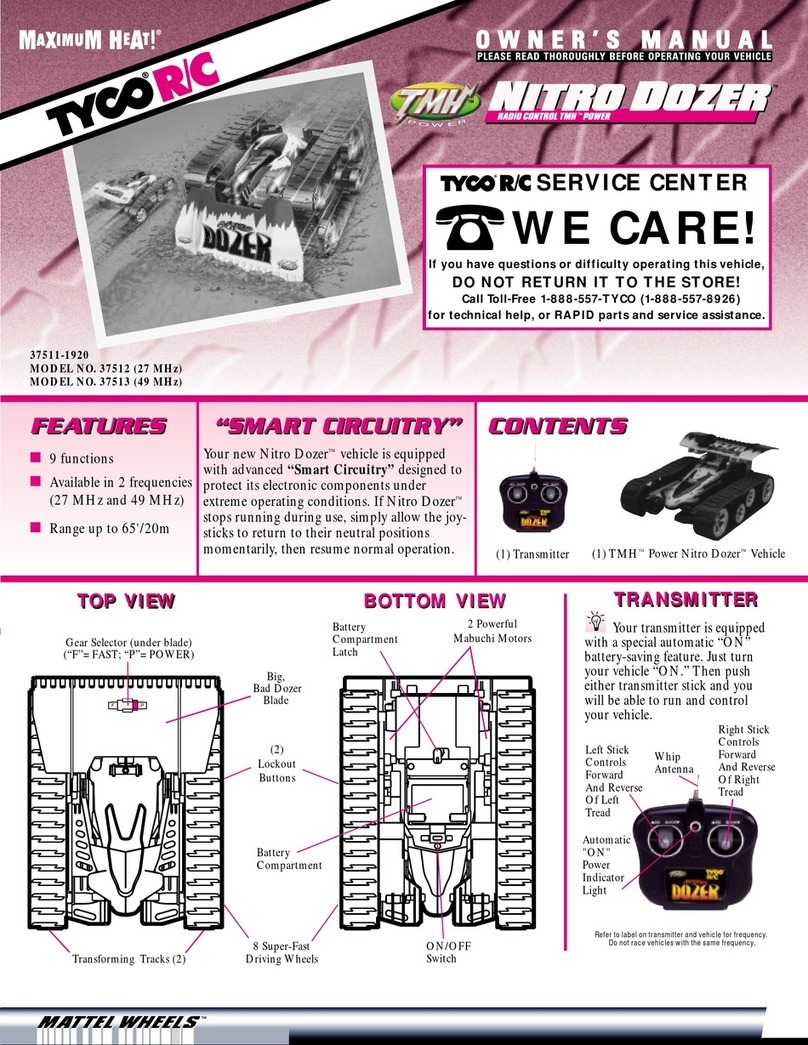
Tyco R/C
Tyco R/C 37512 owner's manual
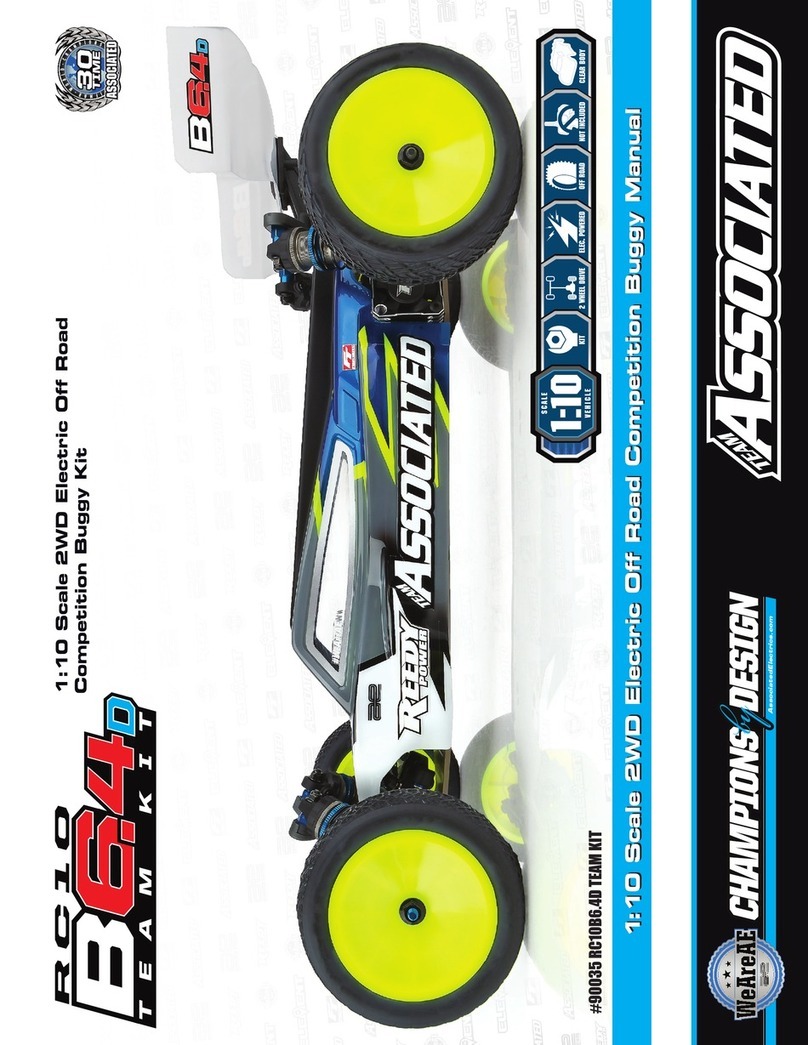
Associated Electrics
Associated Electrics RC10 B6.4D TEAM KIT manual
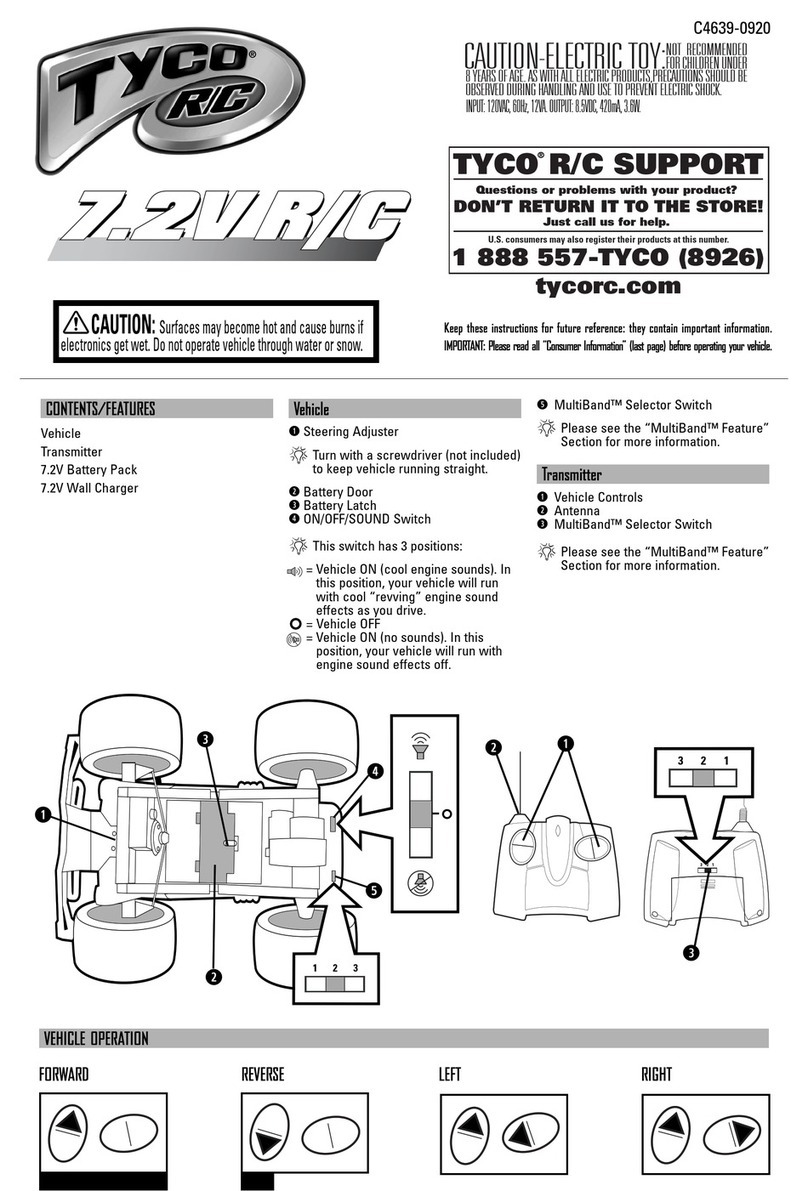
Tyco R/C
Tyco R/C C4639-0920 user manual

REVELL
REVELL Sd.Kfz. 9 FAMO Assembly manual
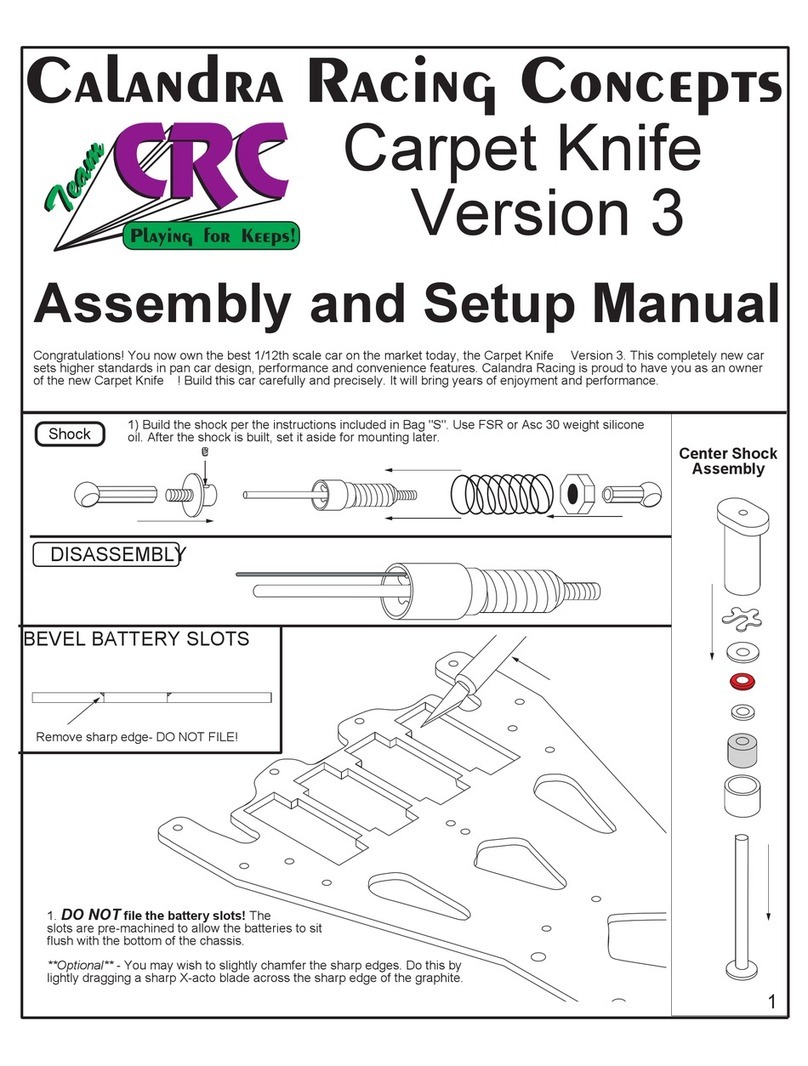
Team CRC
Team CRC Carpet Knifea 3 Assembly and setup manual
